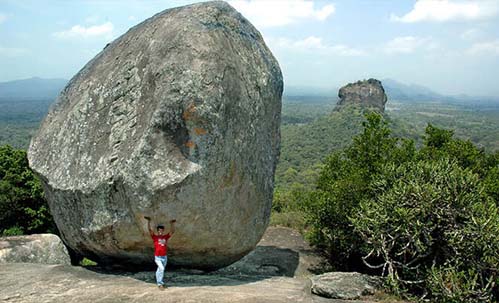Sigiriya is one of the most valuable historical monuments of Sri Lanka. Referred by locals as the Eighth Wonder of the World this ancient palace and fortress complex has significant archaeological importance and attracts thousands of tourists every year. It is probably the most visited tourist destination of Sri Lanka. Sigiriya consists of an ancient citadel built by King Kashyapa during the 5th century. The Sigiriya site contains the ruins of an upper palace located on the flat top of the rock, a mid-level terrace that includes the Lion Gate and the mirror wall with its frescoes, the lower palaces clings to the slopes below the rocks. The moats, walls and gardens of the palace extended for a few hundred metres from the base of the rock. The site was both a palace and a fortress. The upper palace on the top of the rock includes cisterns cut into the rock.

UNESCO World Heritage Site, Sigiriya Rock Fortress, is known as Lion Rock, a private fortress and place of immense stature with a remarkably impressive design. Sigiriya is by far the most popular marquee attraction in all of Sri Lanka. Sigiriya Lion Rock is located in the northern Matale District near the town of Dambulla in the Central Province, Sri Lankais. It is an ancient rock fortress known for its massive column of rock that reaches nearly 200 meters high. The site dates back to the reign of King Kasyapa (477-495 AD), who chose this site as his new capital. He decorated the walls with frescoes, and built an impressive palace right on top of the rock column, accessible only through the mouth of an enormous carved lion. Sigiriya Lions Rock is 200 meters high and visitors can "climb" the 1,200 steps, divided amongst a number of staircases, to the top
According to the ancient Sri Lankan chronicle the Cūḷavaṃsa, this area was a large forest, then after storms and landslides it became a hill and was selected by King Kashyapa (CE 477–495) for his new capital. He built his palace on top of this rock and decorated its sides with colourful frescoes. On a small plateau about halfway up the side of this rock he built a gateway in the form of an enormous lion. The name of this place is derived from this structure; Sinhagiri, the Lion Rock. A series of galleries and staircases emerging from the mouth of a gigantic lion constructed of bricks and plaster provide access to the site.

Located in close proximity to the Sigiriya Rock Fortress, standing 199 metres tall, Pidurangala Rock has a long history which is widely believed to date back to the second century BC and is where a monastery was built by King Kashyapa. Ancient chronicles state that monks who previously resided at Sigiriya were donated the temple by the king before he took to building the marvellous structure atop Sigiriya Rock. The temple consisted of five buildings called ‘Panchavasa’, some of which can still be seen during your visit.
© Copyright IEFF-SRI LANKA. All Rights Reserved
Designed & Devloped by IEFF-SRI LANKA